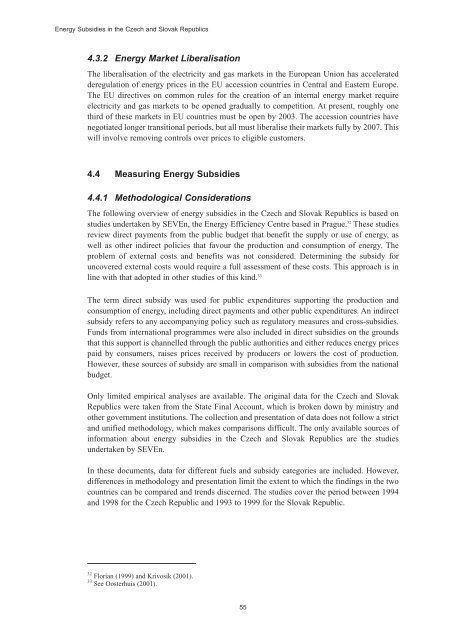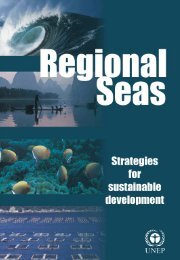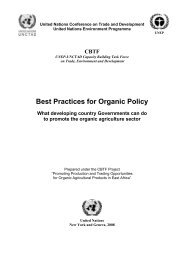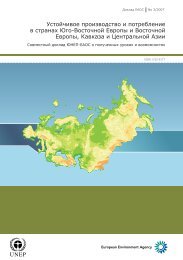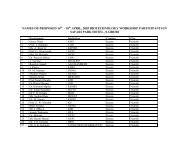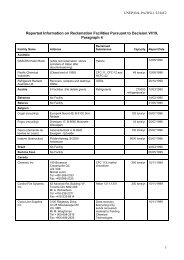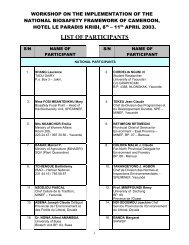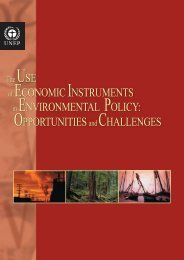Energy Subsidies: Lessons Learned in Assessing their Impact - UNEP
Energy Subsidies: Lessons Learned in Assessing their Impact - UNEP
Energy Subsidies: Lessons Learned in Assessing their Impact - UNEP
You also want an ePaper? Increase the reach of your titles
YUMPU automatically turns print PDFs into web optimized ePapers that Google loves.
<strong>Energy</strong> <strong>Subsidies</strong> <strong>in</strong> the Czech and Slovak Republics<br />
4.3.2 <strong>Energy</strong> Market Liberalisation<br />
The liberalisation of the electricity and gas markets <strong>in</strong> the European Union has accelerated<br />
deregulation of energy prices <strong>in</strong> the EU accession countries <strong>in</strong> Central and Eastern Europe.<br />
The EU directives on common rules for the creation of an <strong>in</strong>ternal energy market require<br />
electricity and gas markets to be opened gradually to competition. At present, roughly one<br />
third of these markets <strong>in</strong> EU countries must be open by 2003. The accession countries have<br />
negotiated longer transitional periods, but all must liberalise <strong>their</strong> markets fully by 2007. This<br />
will <strong>in</strong>volve remov<strong>in</strong>g controls over prices to eligible customers.<br />
4.4 Measur<strong>in</strong>g <strong>Energy</strong> <strong>Subsidies</strong><br />
4.4.1 Methodological Considerations<br />
The follow<strong>in</strong>g overview of energy subsidies <strong>in</strong> the Czech and Slovak Republics is based on<br />
studies undertaken by SEVEn, the <strong>Energy</strong> Efficiency Centre based <strong>in</strong> Prague. 32 These studies<br />
review direct payments from the public budget that benefit the supply or use of energy, as<br />
well as other <strong>in</strong>direct policies that favour the production and consumption of energy. The<br />
problem of external costs and benefits was not considered. Determ<strong>in</strong><strong>in</strong>g the subsidy for<br />
uncovered external costs would require a full assessment of these costs. This approach is <strong>in</strong><br />
l<strong>in</strong>e with that adopted <strong>in</strong> other studies of this k<strong>in</strong>d. 33<br />
The term direct subsidy was used for public expenditures support<strong>in</strong>g the production and<br />
consumption of energy, <strong>in</strong>clud<strong>in</strong>g direct payments and other public expenditures. An <strong>in</strong>direct<br />
subsidy refers to any accompany<strong>in</strong>g policy such as regulatory measures and cross-subsidies.<br />
Funds from <strong>in</strong>ternational programmes were also <strong>in</strong>cluded <strong>in</strong> direct subsidies on the grounds<br />
that this support is channelled through the public authorities and either reduces energy prices<br />
paid by consumers, raises prices received by producers or lowers the cost of production.<br />
However, these sources of subsidy are small <strong>in</strong> comparison with subsidies from the national<br />
budget.<br />
Only limited empirical analyses are available. The orig<strong>in</strong>al data for the Czech and Slovak<br />
Republics were taken from the State F<strong>in</strong>al Account, which is broken down by m<strong>in</strong>istry and<br />
other government <strong>in</strong>stitutions. The collection and presentation of data does not follow a strict<br />
and unified methodology, which makes comparisons difficult. The only available sources of<br />
<strong>in</strong>formation about energy subsidies <strong>in</strong> the Czech and Slovak Republics are the studies<br />
undertaken by SEVEn.<br />
In these documents, data for different fuels and subsidy categories are <strong>in</strong>cluded. However,<br />
differences <strong>in</strong> methodology and presentation limit the extent to which the f<strong>in</strong>d<strong>in</strong>gs <strong>in</strong> the two<br />
countries can be compared and trends discerned. The studies cover the period between 1994<br />
and 1998 for the Czech Republic and 1993 to 1999 for the Slovak Republic.<br />
32 Florian (1999) and Krivosik (2001).<br />
33 See Oosterhuis (2001).<br />
55


